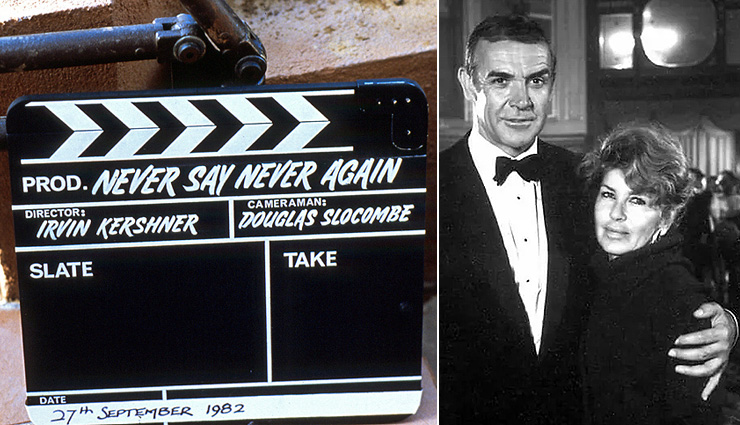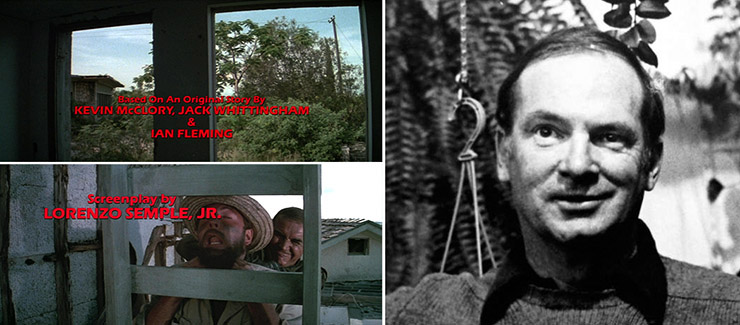|
Never Say |
||
|
||
|
Never Say |
||
|
||
 |
|
Two years passed, and ‘Warhead’, which had now been developed over a four-year period, during which time McClory had injected a substantial amount of time and money, was doomed. Or so everyone thought. Kevin McClory determined to make his James Bond movie ploughed on, looking for new financial backers. During 1980, Kevin McClory’s screenplay fell into the hands of Lorimar, the TV giant and feature film Production Company, best-known for the popular US television series Dallas (1978-1991). The project caught the eye of one particular Lorimar executive, Jack Schwartzman. The New Yorker was educated at UCLA in California, where he specialised in tax law. Five years after joining his first firm as a tax attorney he became a partner, and in 1965 set up his own business. Ten years later Schwartzman, Greenberg and Grakal, was one of Hollywood’s busiest law firms, and he was considered as one of the leading experts in entertainment law. In 1978 he joined Lorimar Productions as Executive Vice President. At the end of 1980, Schwartzman left Lorimar to become an independent Producer, and it was the ‘Warhead’ script that fascinated him. Schwartzman felt McClory had a case, and he had the legal knowledge to untangle the project and make it a reality. Schwartzman moved with caution, and refused to invest substantial funds in the proposal unless Sean Connery was brought back on board. The press meanwhile continued to debate Connery’s re-appearance as 007 with ‘Will he – won’t he?’ type scenarios. |
|||||||||||||
 |
|||||||||||||
|
Sean Connery finally agreed to return to the project, after his wife Micheline suggested he may find it an interesting experience, and the more he mused over the prospect the more enthusiastic he became. Secretly, Sean Connery needed this film. During the late Seventies his career was at a crossroads after several box office failures. Returning as James Bond guaranteed a smash, and a chance to re-launch “Sean Connery” as a bankable film star. Eventually he agreed to play the role one final time if Schwartzman could put a deal together. Jack Schwartzman proclaimed, “Connery said ‘Yes I’d like to do a Bond film. I’d like to play that character again. If you can get the rights and come up with a screenplay and director of my satisfaction, I’m prepared to go ahead.’” With this in mind, Schwartzman began to organise a realistic looking project by finding 26 independent backers, who between them would raise the necessary cash. He then bought the rights from McClory to make one James Bond film, based on the THUNDERBALL story. Schwartzman recalled, “I bought his rights and agreed to give him a credit on the film. Beyond that he’s had no input creatively or in terms of the production. He retains the rights to make more films in the future.” McClory would eventually receive an executive producer’s credit, and Sean Connery would collect a $3 million pay cheque plus a share of the profits. The film would fall under the Taliafilm banner, a production company headed by Talia Shire (sister of director Francis Ford Coppola), who was married to Jack Schwartzman. |
|||||||||||||
|
|||||||||||||
|
Schwartzman knew he could not afford a legal battle with Albert R. Broccoli, who was currently preparing his twelfth 007 film, For Your Eyes Only (1981), again starring Roger Moore. He understood this was where Kevin McClory essentially failed, so immediately threw out the Len Deighton/Sean Connery screenplay, which was quite obviously more than just a re-working of Thunderball, realising it was this that quite naturally had rattled EON. He said, “I deliberately did not purchase the ‘Warhead’ script. At the time I made my deal it was the subject of litigation, and I didn’t want to be tarred with the same brush.’ Schwartzman commissioned screenwriter Julian Plowden (1931-2016) to deliver a treatment, but it was soon receiving a complete revision by Lorenzo Semple Jr (1923-2014). Confined to a strict regime, Semple Jr was briefed to write a modern simple update of Thunderball, nothing more, nothing less. Semple Jr, whose notable screen credits include King Kong (1976), Flash Gordon (1980), and the Sixties Batman TV series (coincidentally all re-makes) recalled his introduction to the project, “Sean wanted this to be the greatest film ever made. I was extremely apprehensive about the idea, because I felt a Bond movie – especially one that’s essentially a remake – would never be the greatest film ever made.” The writer took on the project with the attitude that it “may be fun.” His experience on the film would turn out to be a rather strange kind of fun, not only did he have to satisfy Schwartzman’s demands, but Sean Connery also had 100% script approval. “It was all very jolly at that stage”, recalls Semple Jr, “We agreed that the story would follow the same general construction as the Thunderball film… The major change we made is that Bond is in semi-retirement, and must force his way back into action. He’s the last person M wants involved, because he’s too dangerous and they don’t want to do things like that anymore. They want to get Bond out of the way.” Taliafilm had the rights to feature recurring James Bond characters such as M, Q, and Miss Moneypenny, and were keen to exploit this to the full. “At one point we even had Leiter kicked out of the CIA and working in security for an oil company, but we had to change that back for legal reasons,” recalled Semple Jr. “In the original draft Bond was working in Scotland on a North Sea fishing boat. In the final version, he never really left the service.” |
|||||||||||||
 |
|||||||||||||
|
Lorenzo Semple Jr soon became very agitated with the project. The criteria as to what he could and couldn’t write continually changed. “The rule was anything I could take directly from the book, which hadn’t been used in the original movie, would be a brownie point.” The screenwriter recalled, “It never seemed clear cut what the rules of the game actually were.” While some of the movie’s personnel claim that they had the rights to use any of the original THUNDERBALL material, others suggest they were only entitled to material featured in the Thunderball film. Semple Jr recalls, “The lawyers kept saying, ‘The bottom line is if it’s too different from the Thunderball movie, then you’re not doing a remake you’re doing a sequel.’” |
|||||||||||||
|
|||||||||||||
|
Once completed, Semple Jr sent his 70-page treatment to Connery in Marbella. “Sean liked it, and so did Jack (Schwartzman) – especially when Sean liked it. I’m quite a good narrative writer if I may say. It was a classy, literate, well-written treatment. I threw in many character points, which I knew would appeal to Sean.” With a positive response from Schwartzman and Connery, Semple Jr started to construct a first draft from the treatment. Again, Semple Jr forwarded the work to Marbella. Connery had some ideas, and invited Semple Jr over for a few days. “I thought his ideas were excellent. I listened to him most closely, and did my best to incorporate them into my rewrite.” This was Semple Jr’s first encounter with Sean Connery. “Sean had a great fondness for James Bond.” It was Micheline Connery, who was to give Semple Jr’s work a name, the aptly titled Never Say Never Again. Not only did Connery have script approval, he also had director approval. Sean Connery stipulated from a very early stage that he wanted to make a great movie, “When I first decided to make this film, I made it absolutely clear at the time, that my major concern was to make a film of quality. And I said then, that if we were ever to sacrifice that quality for expediency, I would rather not make the film.” |
|||||||||||||
 |
|||||||||||||
|
Schwartzman first approached director Richard Donner (1930-2021), who’s most recent success had been Superman The Movie (1977), but Donner declined the project. Semple Jr recalls, “Sean wanted Richard Donner very much, but Dick didn’t like the script and didn’t want to do a remake. I was quite alarmed at that fact, because when an actor wants a certain director and the director doesn’t want to do the job, everybody becomes terribly insecure.” The Never Say Never Again script was also sent to veteran James Bond directors Terence Young (1915-1994) and Peter Hunt (1925-2002), who explained: “I would have offended Cubby if I had done it. The whole situation was very poor in their (EON’s) thinking, and I think, if I had done it, they would have thought I was a traitor. We had talks about it, but I wouldn’t have taken it for that reason”. Schwartzman and Connery then asked to meet with Philadelphia born Irvin Kershner (1923-2010), who had a resounding success in 1980 with The Empire Strikes Back, the film many consider to be the strongest episode of the Star Wars saga. Kershner had also originally directed Sean Connery in A Fine Madness in 1966. |
|||||||||||||
|
|
|||||||||||||
|
|||||||||||||
|
|
|||||||||||||